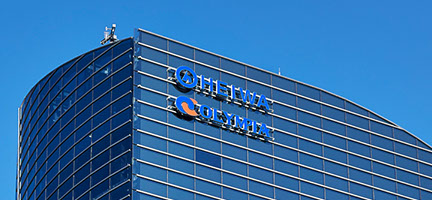A summary of the structures for ensuring the appropriateness of our operations as well the implementation of these structures is as follows:
Structures for ensuring the appropriateness of our operations
-
Structure for ensuring that the execution of duties by directors and employees conforms with laws and ordinances
We ensure compliance by directors and employees in accordance with the Compliance Rules, and as result, individuals improve their personal ethics, and based on their consciences and good sense, conduct fair and sound business activities.
We have established and operate a consultation desk as a means of enabling employees to directly provide information about suspicious conduct pertaining to compliance. We also ensure that whistleblowers are not subject to disadvantageous treatment by, for example, enabling them to remain anonymous if they wish to. -
Structure for the preservation and management of information relating to the execution of duties by directors
Regarding the preservation and management of information relating to the execution of duties by directors, the information is stored in paper or electronic format in accordance with the Document Management Rules, and is preserved and managed in such a way that it can be properly and reliably retrieved. Furthermore, directors and statutory auditors can examine the information at any time.
-
Rules and other structures for managing the risk of loss
We manage the risk of loss by establishing a risk management structure based on the Risk Management Rules.
Under a risk management officer appointed in accordance with the Risk Management Rules, each department takes steps independently, and the general affairs department compiles the steps that each department is taking and performs risk management. -
Structure for ensuring that the execution of duties by directors is efficient
Regarding managerial decision making, we have established Job Authority Rules and Task Allocation Rules, and beginning with the monthly meetings of the Board of Directors, duties are performed by each internal level based on the rules and in accordance with authority entrusted.
At meetings of the Board of Directors, each director reports the action they are taking and the progress they are making to achieve the fiscal-year targets, which constitute the objectives for the entire Company. The directors also discuss issues and decide on specific courses of action. -
Structure for ensuring appropriateness of operations by the corporate group comprising the Company and its subsidiaries
The appropriateness of operations by the corporate group comprising the Company and its subsidiaries is ensured through the application of the Risk Management Rules and Compliance Rules to the Company and its subsidiaries or through other equivalent rules. As for the business management of subsidiaries, in accordance with the Related Company Management Rules, the corporate planning department conducts management for the purpose of enabling subsidiaries to contribute as members of the corporate group to its development while respecting the independence of the subsidiaries and maintaining cooperation with them by receiving reports from them from time to time.
Our internal audit department conducts audits of both the Company and its subsidiaries. -
Matters concerning employees required by statutory auditors to assist them with their duties, matters concerning the independence of these employees from directors, and matters concerning the assurance of the effectiveness of instructions toward these employees
If a statutory auditor requires an employee to assist them with their duties, the Representative Director/President shall assign audit staff from the internal audit department to provide assistance at the request of the statutory auditor, and consult with the statutory auditor about who specifically should be appointed. Furthermore, if, for example, an incident that limits or restricts the effectiveness of instructions from a statutory auditor toward audit staff, the statutory auditor demands that the Representative Director/President or the Board of Directors do whatever necessary to ensure the effectiveness of instructions to audit staff.
-
Structure for reporting to statutory auditors
Our directors and employees as well as directors, statutory auditors and employees of our subsidiaries report to statutory auditors when they discover a fact that could cause serious harm to the corporate group. They also report on the situation with internal audit of the corporate group, information received by the consultation desk, and so on.
Furthermore, if it is not being ensured that persons making such reports are not subject to disadvantageous treatment on account of making the reports, the statutory auditors make demands to the Representative Director/President or the Board of Directors as necessary. -
Structure for ensuring that audits by statutory auditors are conducted effectively
By attending important meetings of the Board of Directors etc., statutory auditors learn about the process of making important decisions and the status of business execution. They also review key circulars and other important documents concerning business execution, and ask directors and employees for explanations of them as necessary.
Furthermore, statutory auditors receive explanations of accounting audits and internal-control audits from our accounting auditor, exchange information, and hold regular meetings with the Representative Director/President to share opinions. -
Matters concerning policies relating to the settlement of expenses or debts arising from execution of duties by statutory auditors
With regard to expenses incurred in the execution of duties by statutory auditors, if statutory auditors request prepayment, reimbursement, etc., the expenses or debts are settled swiftly by the Company. However, statutory auditors shall give consideration to efficiency and reasonableness with respect to audit expenses.
-
Basic approach and preparedness for eliminating antisocial forces
Our basic approach to eliminating antisocial forces is to be resolute in tackling antisocial forces that pose a threat to civic and social order and safety, and we therefore refuse to do business with companies, organizations, and individuals that are connected with such forces.
Directors and employees are made aware of and follow this approach in accordance with the Compliance Rules. -
Structure for ensuring the accuracy of financial reports
To ensure the accuracy of financial reports, we have established and are operating an internal control system so that internal control reports can be submitted effectively and appropriately pursuant to Financial Instruments and Exchange Act.
Overview of implementation of structures for ensuring the appropriateness of our operations
-
Execution of duties by directors
At meetings of the Board of Directors, directors provide monthly reports on the action they are taking and the progress they are making to achieve the fiscal-year targets, and also consider and decide on specific courses of action to tackle important issues. Furthermore, directors delegate authority in accordance with the Job Authority Rules, and by allowing decisions to be made at each level, ensure that execution of duties is efficient.
-
Compliance
In accordance with our Compliance Rules, we employ tools such as our intranet to ensure adherence to rules (our corporate philosophy, management policy, principles of conduct, internal rules, etc.) in order to raise compliance awareness among directors and employees. Subsidiaries also have similar structures in place. During the fiscal year under review, we continued with initiatives from the previous fiscal year such as providing e-learning programs to middle managers and other personnel with the aim of further boosting compliance awareness. We also provided newly hired employees with compliance training as well as training on topics such as the prevention of insider training. Furthermore, we provided employees with information to raise compliance awareness via email.
-
Risk management
In accordance with our Risk Management Rules, we have established a structure for enabling the various risks faced by the Group to be precisely managed and controlled. During the fiscal year under review, we gathered information on and reassessed risks that could have a serious impact on the Company. We also considered preventive measures and actions in the event of risk materialization on an ongoing basis and revised our reporting system for risk materialization. With regard to subsidiaries, we gathered risk information from them and confirmed the actions that they are taking. The internal audit department monitors the status of risk management and reports the results of its monitoring to the Representative Director/President, etc.
-
Group management structure
In accordance with the Related Company Management Rules, we consult with subsidiaries about important matters that affect them in advance, and also receive monthly reports from them about other matters.
-
Execution of duties by statutory auditors
Statutory auditors abide by standards for audits by statutory auditors that are prescribed by the Audit and Supervisory Board, and conduct audits based on an audit policy, division of duties, etc. Furthermore, they attend important meetings of the Board of Directors etc., and meet regularly with the accounting auditor, directors, and internal audit department to exchange opinions. As such, they confirm the current status of business execution by directors as well as the condition and operation of the internal control system. As for subsidiaries, statutory auditors exchange opinions with the directors and statutory auditors of subsidiaries and also receive business reports from employees of subsidiaries as necessary.





